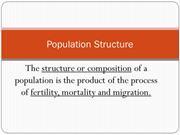China's population
Themost surprising demographic crisis
中国人口
最让人惊讶的人口统计学危机

A new census raisesquestions about the future of China’s one-child policy
DOES China haveenough people? The question might seem absurd. The country has longbeen famous both for having the world’s largest population and forhaving taken draconian measures to restrain its growth. Though manypeople, Chinese and outsiders alike, have looked aghast at thebrutal and coercive excesses of the one-child policy, there hasalso often been a grudging acknowledgment that China needed to dosomething to keep its vast numbers in check.
一轮新的人口统计引出了关于中国独生子女政策未来的问题。
中国人口足够多了吗?这个问题可能看起来荒谬。中国长久以来以拥有世界上最多的人口和采取严厉而措施控制人口增长著称。尽管许多人,包括中国人和外国人,对这种严酷和强制执行的独生子女政策非常不理解,但是他们还是多多少少承认中国确实需要做一些事情以控制其巨大的人口。
But new censusfigures bolster claims made in the past few years that China issuffering from a demographic problem of a different sort: too low abirth rate. The latest numbers, released on April 28th and based onthe nationwide census conducted last year, show a total populationfor mainland China of 1.34 billion. They also reveal a steepdecline in the average annual population growth rate, down to 0.57%in 2000-10, half the rate of 1.07% in the previous decade. The dataimply that the total fertility rate, which is the number ofchildren a woman of child-bearing age can expect to have, onaverage, during her lifetime, may now be just 1.4, far below the“replacement rate” of 2.1, which eventually leads to the populationstabilising.
但是新的人口普查数据支持了过去几年的发现,中国正在遭受另一个不同类型的人口统计学问题:出生率低下。4月28号发布的最新数据是基于去年全国范围内的人口普查的。数据显示中国大陆的人口总数是13亿4千万。他们还揭露了在年度平均人口增长率上的明显下降,从2000年到2010年下降到0.57%,是前一个十年1.07%的一半。数据意味着整个出生率(这是指一个到了生育年龄的妇女在她一生当中可以拥有小孩的数目)现在可能只是1.4,远低于2.1%的“替换率”,这最终导致了人口的稳定。
Slower growth ismatched by a dramatic ageing of the population. People above theage of 60 now represent 13.3% of the total, up from 10.3% in 2000(see chart). In the same period, those under the age of 14 declinedfrom 23% to 17%. A continuation of these trends will place evergreater burdens on the working young who must support their elderlykin, as well as on government-run pension and health-care systems.China’s great “demographic dividend” (a rising share of working-ageadults) is almost over.
人口老龄化与增长率放缓相呼应。60岁以上的人口以占总数的13.3%,多于2000年的10.3%。在同一时期,14岁以下的人口占有率从23%下降到17%。这种趋势继续下去将为处于工作岗位的年青中国人带来到更大的负担,他们必须赡养他们的双亲,这可政府发放养老金和运营卫生保健系统一样。中国巨大的“人口红利”(不断上升的处于工作年龄成年人)的几乎结束。
In addition toskewing the country’s age distribution, the one-child policy hasprobably exacerbated its dire gender imbalance. Many more baby boysare born in China than baby girls. China is not unique in this;other countries, notably India, have encountered similar problemswithout coercive population controls. But Chinese officials do notdispute that the one-child policy has played a role. China’s strongcultural imperative for male offspring has led many families to dowhatever they must to ensure that their one permissible child is ason. In the earliest days of the one-child policy, this sometimesmeant female infanticide. As ultrasound technology spread,sex-selective abortions became widespread.
除了中国人口年龄分布的不平衡,独生子女政策已可能增剧可怕的性别失衡。在中国男婴儿的出生率远远大于女婴儿的出生率。在这方面中国并不是仅有的一个国家,其它国家,特别是印度,这个国家没有强制的人口控制也遭遇了类似的问题。但是中国官员没有质疑独生子女的政策在性别失衡里发挥了作用。中国根深蒂固的男子传统接待的文化导致许多家庭做出他们可以做的任何事情让他们唯一可以出生的小孩必须是儿子。在独生子女政策最早的时候,有时会有危害女婴的事情发生。随着超声波技术的普及,选择性堕胎成了广泛应用。
The new census datashow that little progress is being made to counter this troublingtrend. Among newborns, there were more than 118 boys for every 100girls in 2010. This marks a slight increase over the 2000 level,and implies that, in about 20 or 25 years’ time, there will not beenough brides for almost a fifth of today’s baby boys—with thepotentially vast destabilising consequences that couldhave.
新的人口普查数据显示,在应对不好的趋势时有了一点点进步。在新出生的婴儿中,2010个是118男孩对比100女孩。这比2000年的水平只有细微的上涨,这就意味着,在20年或者25年后,现在出身的男婴儿有近20%的人讨不到老婆---伴随着巨大潜在不确定后果的出现。
The census resultsare likely to intensify debate in China between the powerfulpopulation-control bureaucracy and an increasingly vocal group ofacademic demographers calling for a relaxation of the one-childpolicy. Their disagreement involves not only the policy’s future,but also (as so often in China) its past.
One of the academics,Wang Feng, director of the Brookings-Tsinghua Centre for PublicPolicy, argues that China’s demographic pattern had already changeddramatically by the time the one-child policy began in 1980. Thetotal fertility rate had been 5.8 in 1950, he notes, and haddeclined sharply to 2.3 by 1980, just above replacementlevel.
人口普查的结果可能加强了中国基于强力的人口控制机构和学术人口统计者不断要求放宽独生子女政策的争论。他们的分歧涉及的不仅是政策的将来,还包括了过去(特别是在中国)。
学者之一,王芬,他是布鲁金斯和清华公共政策研究中心的主任,认为中国的人口统计模式自1980开始的独生子女政策以来已有很大的改变。在1950年的出生率是5.8,他说到,到了1980到下降到了2.3,只略高于替换水平。
Other countriesachieved similar declines in fertility during the same period. Thecrucial influences, Mr Wang reckons, are the benefits ofdevelopment, including better health care and sharp drops in highinfant-mortality rates which led people to have many children inorder to ensure that at least some would survive. By implication,coercive controls had little to do with lowering fertility, whichwould have happened anyway. Countries that simply improved accessto contraceptives—Thailand and Indonesia, for instance—did as muchto reduce fertility as China, with its draconian policies. Taiwan,which the government in Beijing regards as an integral part ofChina, cut its fertility rate as much as China without populationcontrols.
其它国家的出生率在同一时期也有类似的下降。王先生认为,关键的影响是发展的利益,包括更好的卫生保健和新出生婴儿高死亡率的显著下降,这也是导致许多人想生多个小孩以确保至少有一两个可以活下去的原因。通过暗示,强制计划生率对降低生率只有一点点作用,有的事情怎么都会发生的。某些国家只是简单的提高了避孕用具使用率(如泰国和印尼),却取得了比中国强制的计划生育政策更好的效果。台湾,当然也是中国的一部分,没有采用计划生育也取得了更好的效果。
The government deniesthe one-child policy was irrelevant. It insists that, thanks to thepolicy, 400m births were averted which would otherwise have takenplace, and which the country could not have afforded. Ma Jiantang,head of China’s National Bureau of Statistics, insisted “themomentum of fast growth in our population has been controlledeffectively thanks to the family-planning policy.”
There are manyreasons for the government’s hard-line defence of its one-childpolicy. One is a perhaps understandable view that China is unique,and that other countries’ experience is irrelevant. A second isthat, though the policy may not have done much to push fertilitydown at first, it might be keeping it low now. A third is that, ifcontrols were lifted, population growth might rise. In fact, thereis little justification for such fears: in practice, the one-childpolicy varies from place to place; it hardly applies to China’sminorities and is more lightly applied in rural areas—and there isno population boom in those parts.
政府否定了独生子女政策失效。它认为,因为政策的执行,中国少生了4亿婴儿,这是中国所不能承受的。马健唐,他是中国国家统计局的一把手,坚持认为“计划生育政策有效的控制了中国人口的快速增长的动力。”
有许多原因让中国的强硬派保护独生子女政策。一个可能是中国国情的独一无二性,而其它国家的经验在此是行不通的。第二个便是,尽管开始时政策对出生率下降并没有多大作用,而现在我们已看到了政策的威力。第三占是,如果现在放弃了独生子女政策,人口增长率可能又会上升。事实上,这种害怕几乎是没有理由的:实践证明,独生子女政策每个地方都不同,这不可以应用于中国的少数民族,而在中国的农村也不怎么好用—在这些地方并没有出现人口爆炸。
Anyway, argues JoanKaufman of the Heller School for Social Policy and Management atBrandeis University, official support for the policy is only partlyto do with its perceived merits: it is also the product ofresistance by China’s family-planning bureaucracy. This has massiveinstitutional clout (and local governments have a vested interestin the fines collected from violators). “The one-child policy istheir raison d’être,” says Ms Kaufman.
Mr Wang and hiscolleagues argue the one-child policy should go. The targetreductions in fertility rates were reached long ago. Current rates,he says, are below replacement levels and are unsustainable. Thetime has come for the first big step: a switch to a two-childpolicy. Research by his group suggests few families in China wouldchoose to have more than two.
不管怎么说,布兰戴斯大学社会方针和管理HS的琼考夫认为,官员支持这个政策只是相当然的看到了它的优点:中国家庭计划机构也强烈反对这种看法(当地政府对触犯此政策的人有严厉的惩罚)。“独生子女政策就是理由”K女士说到。
王先生和他的同事认为独生子女政策是有必要的。出生率计划的减少很早以前便有效果。它说到,现在的出生率,低于替代线,并且是不可以持续的。时间已上了第一个大台阶:开始转换成两个小孩的政策。他的团队研究认为中国新组成的家庭应该生两个或两个以上的小孩。
There are signs thatthe academics are succeeding in their campaign to make thepopulation debate less politicised and more evidence-based. Mr Maof the National Statistics Bureau spoke not only of adhering to thefamily-planning policy, but also of “cautiously and graduallyimproving the policy to promote more balanced population growth inthe country”. In his comments on the census, President Hu Jintaoincluded a vague hint that change could be in the offing. Chinawould maintain a low birth rate, he said. But it would also “stickto and improve” its current family-planning policy. That hardlyseems a nod to a free-for-all. But perhaps a “two-for-all” may notbe out of the question.
有迹象显示学术界在这次争论成了赢家,争论是焦点是,人口讨论应该少一些政治化,而因让事实说话。国家统计局的马先生说出的不仅是关于家庭计划的政策,还是关于“小心而逐渐的改进政策以推动国家人口的平衡增长,“在他关于人口普查的讲话里,胡锦涛主席隐约的暗示马上将会有改变。中国应该坚持降低出生率,他说到。但是它也应该“坚持和改进”它目前的家庭计划政策。这很难看到完全自由生小孩的批准。两是生两个可能已不是问题咯!
http://www.economist.com/
 爱华网
爱华网

